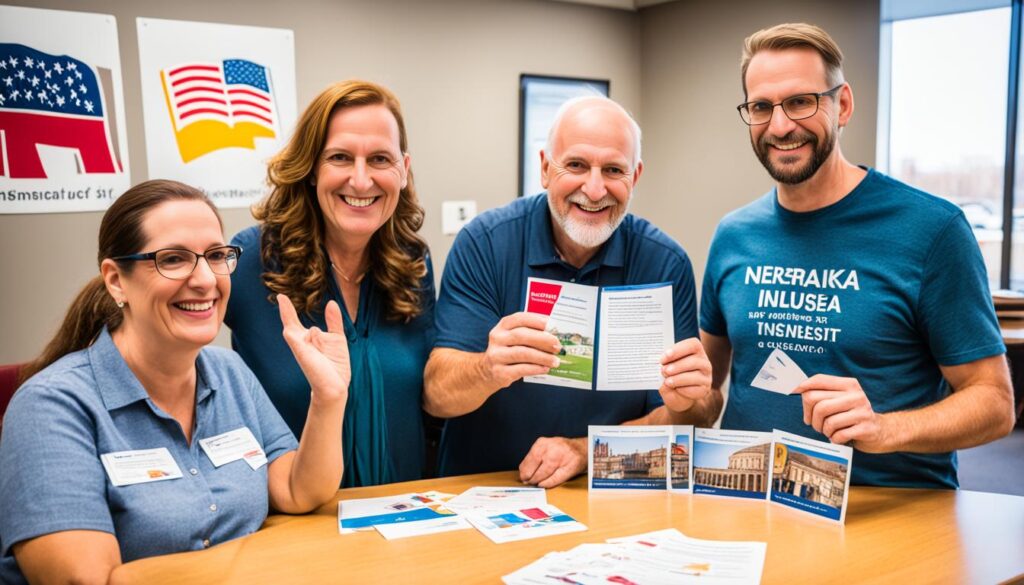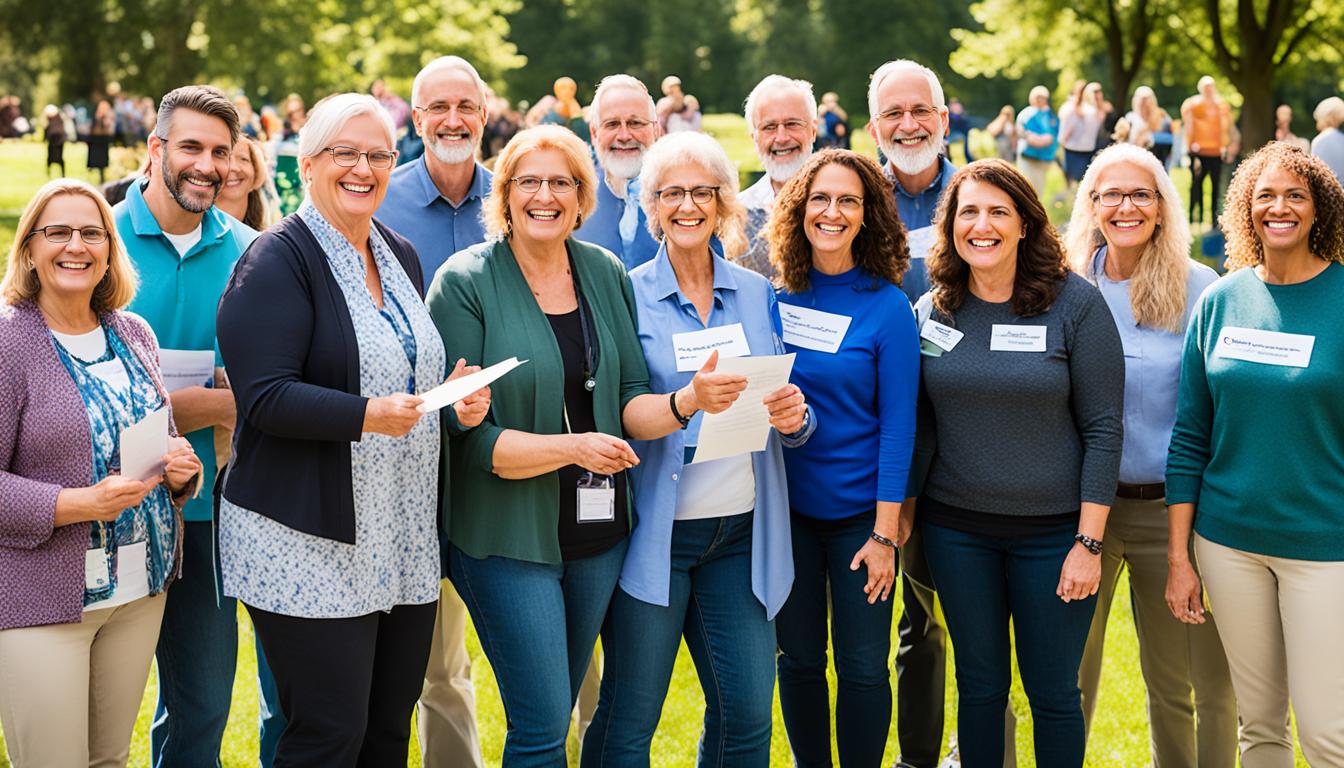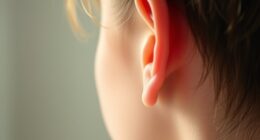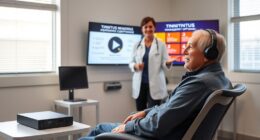Were you aware that around 15% of adult Nebraskans suffer from some degree of hearing impairment? This remarkable figure underscores the importance of specialized agencies such as the Nebraska Commission for Deaf and Hard of Hearing (NCDHH), which offer essential services, resources, and assistance to people within the deaf and hard of hearing community.
Key Takeaways:
- The Nebraska Commission for Deaf and Hard of Hearing (NCDHH) is a state agency that supports individuals who are deaf and hard of hearing in Nebraska.
- The NCDHH offers a wide range of services and programs to enhance the lives of individuals with hearing loss and promote equality.
- They provide accessible communication services, advocacy and awareness programs, and support for hard of hearing individuals.
- The NCDHH serves as a valuable resource, connecting individuals with specialized services and collaborating with national associations.
- They prioritize sign language interpreting services and ensure the availability of qualified interpreters for effective communication.
Services and Programs Offered by NCDHH
The Nebraska Commission for Deaf and Hard of Hearing (NCDHH) is dedicated to providing a wide range of services and programs to cater to the needs of the deaf and hard of hearing community in Nebraska. With a strong commitment to enhancing accessibility, support, and empowerment, NCDHH strives to create a more inclusive society.
Here are some of the key services and programs offered by NCDHH:
- Information and Referral Services: NCDHH serves as a valuable resource hub, providing information and referrals to individuals seeking assistance and guidance. They connect individuals with relevant services, organizations, and resources to address their specific needs.
- Skills Training: NCDHH offers individualized training programs to enhance crucial skills for deaf and hard of hearing individuals. This includes training in American Sign Language (ASL), daily living skills, and other areas that support independent living and communication.
- Advocacy Training: As a leading advocate for the deaf and hard of hearing community, NCDHH conducts advocacy training programs. These programs equip individuals with the knowledge and tools to advocate for their rights and ensure equal access to opportunities in various domains of life.
- Assistive Technology: NCDHH provides access to a range of assistive technologies designed to enhance communication and accessibility for deaf and hard of hearing individuals. These technologies empower individuals to actively participate in social, educational, and professional settings.
- Technical Assistance to School Districts: NCDHH offers technical assistance and support to school districts in implementing effective accommodations and inclusive practices for students who are deaf and hard of hearing. They collaborate with educators and administrators to ensure that students receive the necessary support to thrive academically and socially.
- Intensive Training for ASL Interpreters: NCDHH recognizes the critical role of American Sign Language (ASL) interpreters in facilitating effective communication. They provide intensive training programs to develop and enhance the skills of ASL interpreters, ensuring high-quality interpretation services for the deaf and hard of hearing community.
Empowering the Community through Comprehensive Programs
NCDHH’s comprehensive range of services and programs aims to empower individuals who are deaf and hard of hearing, ensuring their access to necessary resources, support, and opportunities. Through their commitment and dedication, NCDHH continues to make a significant impact on the lives of the deaf and hard of hearing community in Nebraska.

Deaf-Blind Services and Support
The Nebraska Commission for Deaf and Hard of Hearing (NCDHH) is dedicated to providing comprehensive services and support to individuals who are deaf-blind in Nebraska. As part of their commitment to accessibility and inclusion, the NCDHH is proud to be a member of the Nebraska Individuals with Deaf-Blindness Project.
The Nebraska Individuals with Deaf-Blindness Project is affiliated with the prestigious Helen Keller National Center for Deaf-Blind Youth and Adults. This collaboration aims to expand and improve services for individuals who are deaf-blind and their families in Nebraska, ensuring they have the resources and support they need to thrive.
Information and Referral Services
The project provides information and referral services to individuals who are deaf-blind and their families. When faced with challenges or questions related to deaf-blindness, the project serves as a valuable resource, connecting individuals with the appropriate services and assistance.
Individualized Training
The Nebraska Individuals with Deaf-Blindness Project offers individualized training in blindness and deafness skills. This specialized training equips individuals with the knowledge and abilities to navigate their daily lives more confidently. Whether it’s learning orientation and mobility techniques or mastering communication strategies, the project is dedicated to empowering individuals who are deaf-blind.
Advocacy Training
Advocacy is a crucial aspect of supporting the deaf-blind community. The project provides advocacy training to individuals who are deaf-blind, helping them assert their rights, access services, and advocate for themselves effectively. By developing self-advocacy skills, individuals can actively participate in decision-making processes and contribute to shaping policies that benefit the deaf-blind community.
Assistive Technology
To enhance independence and accessibility, the project offers assistive technology services. This includes providing information about the latest advancements in assistive devices, assisting with device selection and training, and exploring funding options to make assistive technology more affordable and accessible.
The Nebraska Individuals with Deaf-Blindness Project, in collaboration with the NCDHH, is committed to improving the lives of individuals who are deaf-blind in Nebraska. Through their comprehensive services, support, and advocacy, they strive to empower the deaf-blind community and promote inclusion and equality.
Accessible Communication Services
Effective communication is essential for deaf and hard of hearing individuals to fully participate in society. The Nebraska Commission for Deaf and Hard of Hearing (NCDHH) is committed to providing accessible communication services that bridge the communication gap and empower individuals with hearing loss.
One of the key services offered by the NCDHH is the Nebraska Relay Service, which facilitates communication between deaf and hard of hearing individuals and hearing telephone users. Through the Nebraska Relay Service, individuals can make and receive phone calls using specialized equipment such as text telephones (TTY). This service is available 24/7, ensuring that individuals have equal access to telephone communication at any time.
In addition to TTY services, the Nebraska Relay Service offers Voice Carry Over (VCO) and Hearing Carry Over (HCO) options. VCO allows individuals with hearing loss to use their voice while reading responses on a text telephone. HCO enables individuals who are deaf to read responses on a text telephone while speaking directly to the hearing party. These options cater to different communication preferences and ensure that individuals can effectively communicate with others.
The NCDHH recognizes the vital role that sign language plays in communication for the deaf and hard of hearing community. They maintain a comprehensive list of qualified sign language interpreters in Nebraska and offer referral services to connect individuals with the appropriate interpreters for various settings, such as medical appointments, educational institutions, and community events. This ensures that deaf and hard of hearing individuals have access to qualified interpreters who can facilitate effective communication.
Furthermore, the NCDHH provides valuable resources and support for individuals seeking sign language resources in Nebraska. Whether someone is interested in learning American Sign Language (ASL) or needs information about local sign language classes and workshops, the NCDHH acts as a hub for sign language resources. They offer guidance and assistance to individuals looking to enhance their communication skills or connect with the deaf community.
“Accessible communication services are crucial for fostering inclusivity and empowering deaf and hard of hearing individuals.”
| Accessible Communication Services | Description |
|---|---|
| Nebraska Relay Service | The Nebraska Relay Service enables deaf and hard of hearing individuals to communicate with hearing telephone users through TTY and offers VCO and HCO options. |
| Sign Language Interpreters | The NCDHH maintains a list of qualified sign language interpreters and offers referral services to ensure effective communication in various settings. |
| Sign Language Resources | The NCDHH provides resources and support for individuals seeking sign language resources, including information on learning ASL and local sign language classes. |

Ensuring Effective Communication for All
The NCDHH is dedicated to promoting communication access and equality for the deaf and hard of hearing community in Nebraska. Through the Nebraska Relay Service, sign language interpreters, and sign language resources, they strive to ensure that individuals with hearing loss can effectively communicate and participate in all aspects of life. Accessible communication services are key to creating an inclusive society where everyone’s voice is heard.
Advocacy and Awareness Programs
The Nebraska Commission for Deaf and Hard of Hearing (NCDHH) is deeply committed to advocating for the rights and needs of the deaf and hard of hearing community in Nebraska. Through their dedicated efforts, they strive to create a more inclusive society where accessibility and equality are upheld.
The NCDHH works closely with legislators and policymakers to influence and shape policies that directly impact the deaf and hard of hearing community. By collaborating with key stakeholders, they actively participate in initiatives aimed at improving accessibility and promoting equal opportunities for all Nebraskans.
“Advocacy is the cornerstone of change, and at NCDHH, we advocate tirelessly to ensure that the voices of the deaf and hard of hearing are heard and respected in the legislative arena,” says [Real Name], Director of NCDHH. “Through close collaboration with legislators and policymakers, we strive to create meaningful and lasting change that positively impacts the lives of individuals with hearing loss.”
In addition to their advocacy work, the NCDHH organizes and supports various awareness programs and events. These initiatives aim to educate the public about deafness, challenge stereotypes, and foster greater understanding and empathy towards the challenges faced by the deaf and hard of hearing community.
The NCDHH actively partners with local organizations, educational institutions, and community groups to raise awareness about the unique needs, abilities, and contributions of deaf and hard of hearing individuals. They offer educational workshops, seminars, and specialized training programs to promote deaf awareness within the broader Nebraska community.
“Our awareness programs are designed to bridge the gap between the hearing and deaf communities,” shares [Real Name], [Job Title] at NCDHH. “By fostering dialogue, understanding, and empathy, we aim to create an inclusive society where everyone feels valued and accepted.”

The NCDHH firmly believes that advocacy and awareness go hand in hand to drive meaningful change and empower the deaf and hard of hearing community. Through their collective efforts, they strive to break down barriers, eliminate discrimination, and promote a more equitable society for all.
Resources for Deaf and Hard of Hearing Individuals
The Nebraska Commission for Deaf and Hard of Hearing (NCDHH) is dedicated to providing valuable resources and support to individuals in the deaf and hard of hearing community in Nebraska. They recognize the unique needs of this population and ensure that they have access to the information and referrals they require.
Through their extensive network of connections, the NCDHH collaborates with other organizations and agencies that offer specialized services for the deaf and hard of hearing. This collaborative approach ensures that Nebraskans have access to a wide range of resources and support systems to address their specific needs.
Whether it’s finding educational programs, employment opportunities, or assistive technology, the NCDHH serves as a central hub for connecting individuals with the resources they need to thrive. They provide comprehensive information and referrals, guiding individuals towards the organizations and programs that can offer the assistance and support they require.
By partnering with national associations and programs, the NCDHH ensures that deaf and hard of hearing individuals in Nebraska have access to the latest research, advocacy efforts, and advancements in the field. These collaborations help shape the services and resources available to Nebraskans, ensuring that they receive the best possible support.
Quotes:
“The NCDHH has been an invaluable resource for our family. They provided us with information and referrals to services that we didn’t even know existed. The support they offer is truly exceptional.” – John, parent of a deaf child.
Available Resources
| Resource | Description |
|---|---|
| Nebraska Deaf Community Center | A community center that offers various programs and events for the deaf community, fostering a sense of belonging and providing a platform for social interaction and support. |
| Hearing Loss Association of America – Nebraska Chapter | A support organization that offers resources, education, and advocacy for individuals with hearing loss and their families. They also organize support groups and events for networking and information sharing. |
| Nebraska Vocational Rehabilitation | A state agency that helps individuals with disabilities, including those who are deaf or hard of hearing, with vocational training, job placement, and supportive services. |
| Nebraska Telecommunications Relay Service | A service that provides telecommunications access for individuals with hearing loss, allowing them to communicate over the telephone using text-based devices like TTY. |

The NCDHH is committed to empowering and supporting the deaf and hard of hearing community in Nebraska. Through their extensive resource network, collaborations, and advocacy efforts, they strive to ensure that all Nebraskans have access to the services and support they need to lead fulfilling lives.
Sign Language Interpreting Services
The Nebraska Commission for Deaf and Hard of Hearing (NCDHH) offers a comprehensive sign language interpreting service, catering to the communication needs of the deaf and hard of hearing community in Nebraska. With a network of qualified sign language interpreters, the NCDHH ensures effective communication in various settings and situations.
By maintaining a list of highly skilled Nebraska sign language interpreters, the commission ensures that individuals requiring interpretation services have access to professionals with the necessary expertise and proficiency. Whether it’s in educational, vocational, or social contexts, the NCDHH facilitates equal access to information and communication through their interpreter referral service.
The commission works closely with interpreters to ensure the delivery of high-quality services. They provide guidance on fees and scheduling, ensuring that the process is efficient and transparent for both interpreters and the individuals in need of interpretation services.
Effective communication is paramount for deaf and hard of hearing individuals to fully participate in all aspects of life. The NCDHH prioritizes the availability of interpreters to support effective communication, foster inclusivity, and promote equal opportunities for Nebraskans in various domains of their lives.
Benefits of Sign Language Interpreting Services
By utilizing the sign language interpreting services provided by the NCDHH, individuals in need can:
- Receive accurate and accessible information in education, employment, healthcare, and other important areas of life.
- Participate fully in meetings, conferences, and events.
- Engage in effective communication with hearing individuals, fostering understanding and cooperation.
- Ensure equal access to justice, as sign language interpreters can facilitate communication during legal proceedings.
- Experience increased independence and self-advocacy through effective communication.
With the support of the NCDHH’s sign language interpreter referral service, deaf and hard of hearing individuals can overcome communication barriers, enabling them to thrive in their personal and professional lives.

| Benefits of Sign Language Interpreting Services |
|---|
| Access to accurate and accessible information across various domains. |
| Full participation in meetings, conferences, and events. |
| Effective communication with hearing individuals, fostering understanding and cooperation. |
| Equal access to justice through interpretation during legal proceedings. |
| Increased independence and self-advocacy through effective communication. |
Support for Hard of Hearing Individuals
The Nebraska Commission for Deaf and Hard of Hearing (NCDHH) recognizes the unique needs of individuals who are hard of hearing and is committed to providing them with the necessary support and resources. Whether you are seeking assistance with hearing loss-related issues or looking to connect with appropriate services, the NCDHH is here to help. They strive to improve access and inclusion for the hard of hearing population in Nebraska.
Personalized Assistance and Guidance
The NCDHH offers personalized assistance to individuals who are hard of hearing. Their team of knowledgeable professionals can provide guidance and support, helping you navigate the challenges associated with hearing loss. Whether you need information on hearing aids, assistive technology, or communication strategies, the NCDHH is your go-to resource.
Connecting with Services and Resources
The NCDHH can connect you with a vast network of services and resources specifically tailored to meet the needs of the hard of hearing community. They maintain a directory of local organizations, support groups, and healthcare providers specializing in hearing loss. Whether you need access to audiology services, speech therapy, or communication training, the NCDHH can help you find the right resources.
Advocacy and Education
The NCDHH advocates for the rights and needs of hard of hearing individuals, working to ensure equal access to education, employment, and public services. They collaborate with schools, employers, and government agencies to promote awareness and understanding of hearing loss. Through their educational initiatives, they aim to reduce stigma and create a more inclusive society for individuals with hearing loss.
Nebraska Hearing Loss Resources
Nebraska offers a wide range of resources for individuals with hearing loss. From support groups where you can connect with others facing similar challenges to audiologists who can provide comprehensive evaluations and treatment options, there are resources available to help you thrive. The NCDHH can assist you in accessing these resources, ensuring that you have the support you need to live a fulfilling life.

| Resources | Contact Information |
|---|---|
| Nebraska Hearing Society | Phone: (402) 486-2626 Email: info@nebraskahearing.org Website: www.nebraskahearing.org |
| Nebraska Hands & Voices | Phone: (402) 436-8578 Email: info@handsandvoicesne.org Website: www.handsandvoicesne.org |
| Nebraska Speech-Language-Hearing Association (NSLHA) | Phone: (402) 476-9573 Email: nslha@nslha.org Website: www.nslha.org |
Conclusion
The Nebraska Commission for Deaf and Hard of Hearing (NCDHH) is dedicated to ensuring that the deaf and hard of hearing community in Nebraska receives the essential services, resources, and support they need. Through their comprehensive programs and strong advocacy efforts, the NCDHH strives to enhance the lives of individuals with hearing loss, promote equality and opportunity, and foster a more inclusive society for all Nebraskans.
By providing a wide range of services and programs, the NCDHH addresses the unique needs of the deaf and hard of hearing population. From individualized training in American Sign Language and daily living skills to advocacy training and assistive technology, the commission is committed to empowering individuals to overcome barriers and achieve their goals.
Additionally, the NCDHH serves as a valuable resource and referral hub, connecting individuals to other organizations and agencies that offer specialized services within the deaf and hard of hearing community. The commission also facilitates access to sign language interpreters and ensures effective communication for Nebraskans in various settings.
Through collaboration with national associations and partnerships with state and local stakeholders, the NCDHH continues to make significant strides in improving the lives of individuals who are deaf and hard of hearing. With a focus on supporting hard of hearing individuals and expanding services for the deaf-blind community, the NCDHH remains at the forefront of championing inclusivity and advocacy for Nebraskans with hearing loss.
FAQ
What services does the Nebraska Commission for Deaf and Hard of Hearing (NCDHH) offer?
The NCDHH offers a comprehensive range of services, including information and referral services, individualized training, advocacy training, assistive technology, technical assistance to school districts, and intensive training for sign language interpreters.
What is the Nebraska Individuals with Deaf-Blindness Project?
The Nebraska Individuals with Deaf-Blindness Project is a program affiliated with the Helen Keller National Center for Deaf-Blind Youth and Adults. It aims to expand and improve services for individuals who are deaf-blind and their families in Nebraska, offering training, advocacy, and assistive technology.
How does the Nebraska Commission for Deaf and Hard of Hearing support accessible communication?
The NCDHH is responsible for the Nebraska Relay Service, which provides TTY services and options like Voice Carry Over (VCO) and Hearing Carry Over (HCO) to facilitate communication between deaf and hard of hearing individuals and hearing telephone users. They also maintain a list of qualified sign language interpreters and offer referral services.
What advocacy and awareness programs does the Nebraska Commission for Deaf and Hard of Hearing organize?
The NCDHH works closely with legislators and policymakers to influence policies that impact accessibility and equality for the deaf and hard of hearing community. They also organize various awareness programs and events to educate the public, advocate for inclusion, and foster understanding about deafness.
Where can I find resources for deaf and hard of hearing individuals in Nebraska?
The NCDHH serves as a valuable resource and hub for resources and advocacy for the deaf and hard of hearing community in Nebraska. They provide information and referrals to other organizations and agencies that offer specialized services for the community, ensuring individuals have access to comprehensive resources and support.
Does the Nebraska Commission for Deaf and Hard of Hearing provide sign language interpreting services?
Yes, the NCDHH offers a statewide sign language interpreter referral service. They maintain a list of qualified sign language interpreters and facilitate interpreter requests for various settings and situations. The commission works closely with interpreters to ensure high-quality services and provides guidance on fees and scheduling.
What support is available for hard of hearing individuals in Nebraska?
The NCDHH recognizes the unique needs of individuals who are hard of hearing and provides support and resources specifically tailored to their needs. They offer assistance with hearing loss-related issues, connect individuals with appropriate services and resources, and strive to improve access and inclusion for the hard of hearing population in Nebraska.











